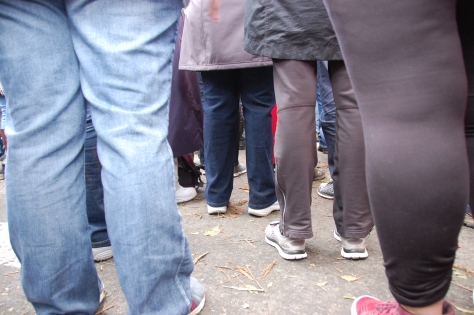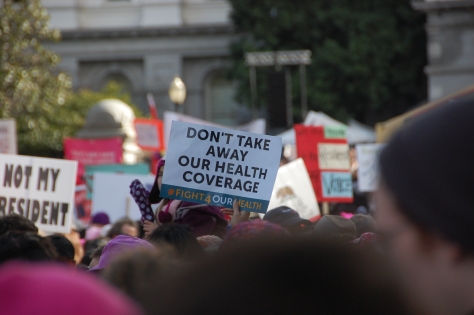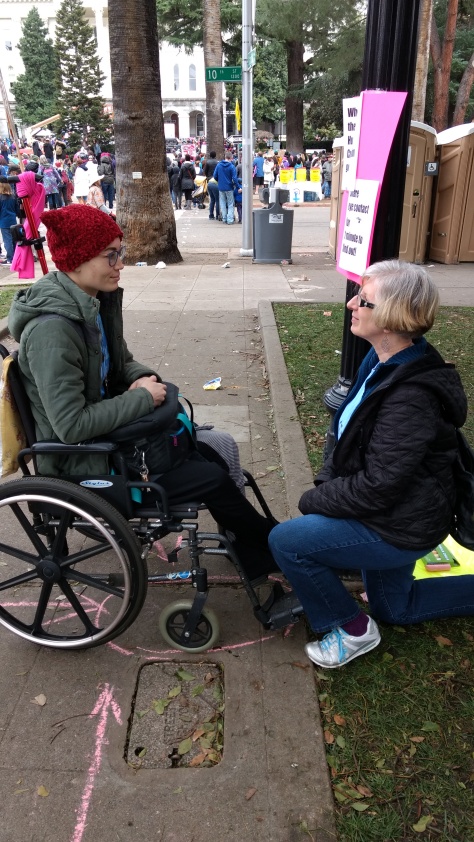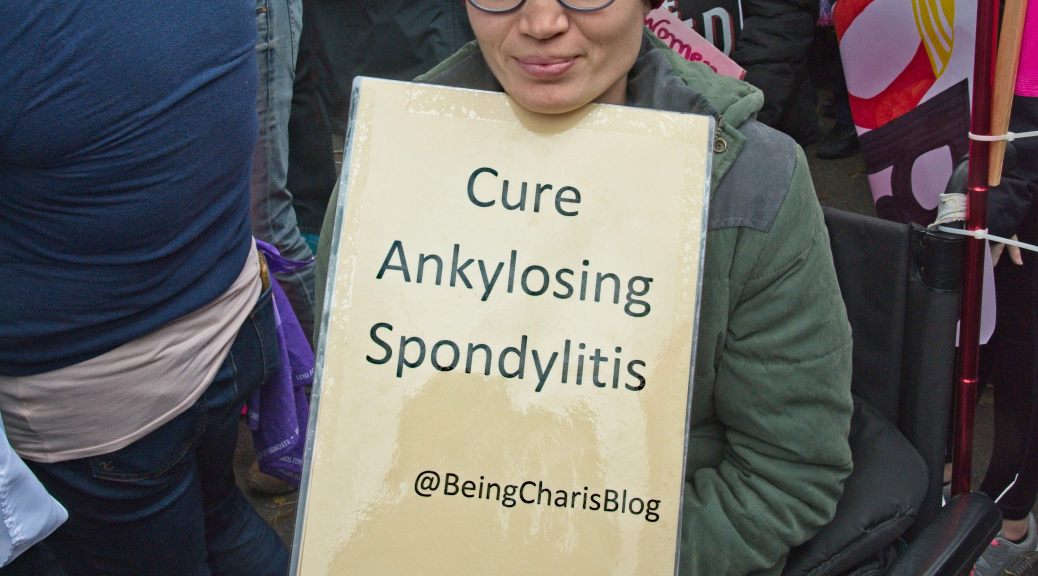The first time I used a wheelchair was after tearing my ACL during a college soccer match in Washington, D.C. in 2005. My teammates convinced me to use one when we visited the Holocaust Museum, instead of crutches. I remember feeling invisible. I remember being trapped in the middle of congested hallways and exhibit rooms, seeing nothing but the backs of people scooting around and in front of me like I was a planter box in their way. I remember feeling empathy for people who spend a majority of their lives in a wheelchair. I hardly remember anything about the museum from that visit. And I became terrified of ever needing to use a wheelchair again.
On January 21st, 2017, I rolled in the Women’s March on Sacramento alongside some 30,000 people. I have only recently, very reluctantly, decided to begin using a wheelchair because of deteriorating health. My experience from college still haunts me, but I am learning to embrace how much more fully I can participate in life by using assistive devices that reduce pain and fatigue caused by Ankylosing Spondylitis. It’s the difference between staying home and showing up.
However, I was nervous about navigating the march, even with friends to help push me. I expected that I would spend all my energy advocating for space just to be able to proceed in a straight line. I thought I might regret the decision to use the chair, even though not using it could result in being bedridden for days or weeks.
Would I return home wishing I had not gone?
I was mistaken. At every turn, with almost every wheel rotation, people moved aside without hesitation, even when I tapped them and asked for space. I suppose it didn’t hurt that I had a sign on a stick that heightened my presence, quite literally.

During the latter half of the march I even felt comfortable rolling away from my friends to get closer and, because it was so easy to maneuver, finally close enough that I reached the ADA space a passing organizer had mentioned early on.
Easy. Did I just say easy to maneuver?
It’s never easy to navigate crowds with a wheelchair. Usually in crowds like this there is a constant parade of passers-by stepping over my feet, darting sideways in front of me, nearly sitting on my lap in the process, and even sometimes supporting themselves on my chair or shoulders. But on this day, in a crowd where barely anyone could move, people made room for me. People stopped in their tracks to let me pass.
(Oh, and if you didn’t already know, if someone is using a wheelchair everyone around them assumes that they know how to use it. I’m still learning, and this was a crash course.)

I want to thank the people who looked me in the eyes, not just at my chair; for saying, “Excuse me” or “I’m sorry” when they realized they had suddenly stepped in front of me (sometimes after being bumped from behind). While I dislike the fact that I am disabled; being seen and validated, respected and humanized, made it easier to sit at butt-height in the middle of a crowd of people, my sign levitating from an invisible arm sticking straight up – the only way to be seen in a crowd of 30,000 people.
I want to thank the march organizer who cut people off as she sidestepped her way over to tell me about the ADA area up front – it didn’t matter in that moment that I would never get there because of the magnitude of the crowd. It mattered that she noticed me, and that she was thinking of me as she rushed past.

Thank you to Myles, a friend who pushed me; and to Anne, his wife, for staying with us the whole way despite getting separated from our group of Episcopalians in the dense crowd.
Thank you to the woman with the sign below, who tapped the ‘disabled’ part as she walked by, to make sure I saw that I was included. Ordinarily, it would have bothered me that she was singling me out (would she have tapped the sign while passing a black person, for instance?), but her face showed no pity. Her face showed acknowledgment of me as a whole person, with my disability simply being one of many facets, and for that I remain grateful. You see, I spend a majority of my energy seeking validation that I am disabled, because on the surface I appear perfectly healthy and able. For once, I was thankful for the wheelchair bringing my invisible disability to the forefront.

Thank you to the teenage boy who practically danced on tiptoes backwards in his desperation to not impede my way forward, who then asked which direction I was going so he wouldn’t step in front of me, who then asked if he could help in some way.
And, thank you to Dee, a retired pastor who offered a minute of “human connection” after the crowds had thinned, who I discovered as I was leaving the event. Thank you for giving me one final reason to feel seen and whole during an event that I would not have been able to participate in without the use of a wheelchair.

I do not speak for every person with a disability when I say that my experience on January 21st was heartwarming and even positive. This march and many marches around the USA and world were far from perfect when it came to accessibility for people with mobility-impairing physical disabilities and for people with mental disabilities. We cannot become complacent until we reach a point where accessibility is common sense. But after my experience at the Sacramento march, I feel we are somehow closer than ever.
And I know we’ll get there, someday.
So for now, I’ll stick with a sincere thank you.


Wow. What incredible efforts for making your voice heard, and glad that the day turned out to be a positive experience for you!
I have nominated you for a ‘One Lovely Blog Award’ because I love reading your blog and for all your efforts for raising awareness of your condition. Check it out: https://brainlesionandme.com/2017/02/02/one-lovely-blog-nomination/
LikeLiked by 1 person
Thank you for your lovely message and sweet nomination!!!!! 🙂
LikeLike
Thank you for sharing what turned out to be a very positive experience for you while bravely using a wheelchair to participate in The Women’s March. I thank you from the bottom of my heart for sticking up for all women everywhere as well as for all those who are going through life with disabilities. I worry that you got very tired, and I also worry that you got cold. When I was younger (and more healthy), I was in a club that made lap blankets for people in wheelchairs. I did not understand why they would get cold while sitting in a wheelchair. Now I understand. Thank you for braving the cold for all of us.
I too recently and reluctantly began using an assistive device. I don’t have my own wheelchair but there are several stores that have electric scooters for shoppers, Costco for example. If not for that scooter, I could not go shopping with my husband. We went last week, it was the first time I left the house in a month, and I used the scooter. Unfortunately, most of the shoppers were inconsiderate and did not think twice about staring at me (because I don’t “look” sick), cutting me off, blocking me, bumping into me as though I were part of a store display, dashing across the main aisle in front of me, forcing me to slam on the brakes so as not to crash with them, even though I was going extremely slowly in order to give people the chance to see me. I have to admit that toward the end of the shopping, I was using the scooter at full speed and not caring if people crashed into me.
Thank you Charis, for your blog, and for being such a brave person.
LikeLiked by 1 person
Thank you for sharing, GMW.
LikeLike
I marched in Washington. This is the first time I can say that the flare and pain were worth it!
LikeLiked by 1 person
Yes! I’m so glad you were there!
LikeLike
Thank you for sharing this powerful reflection of your experience. I’m so glad that you chose to participate. – Judy
LikeLike
Thank you Judy
LikeLike
Charis, I am so glad you had a positive experience. You sound upbeat and joyous. It can be surprising to learn that the lifting of just a little bit of depression can make a major change. You are a wonder.
LikeLike
Thank you, Ken. The experience buoyed me for a few days.
LikeLike
Thank you, Charis, for writing and sharing this. Kind regards, Rich
LikeLike
Thanks for reading, Rich.
LikeLike